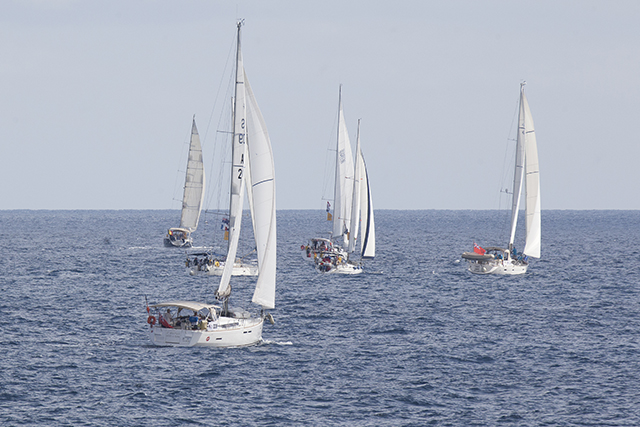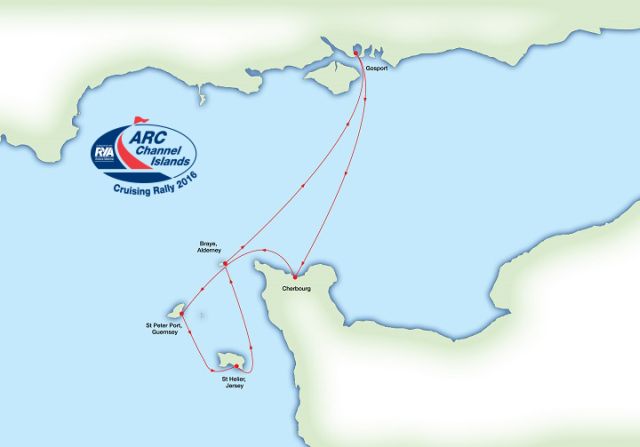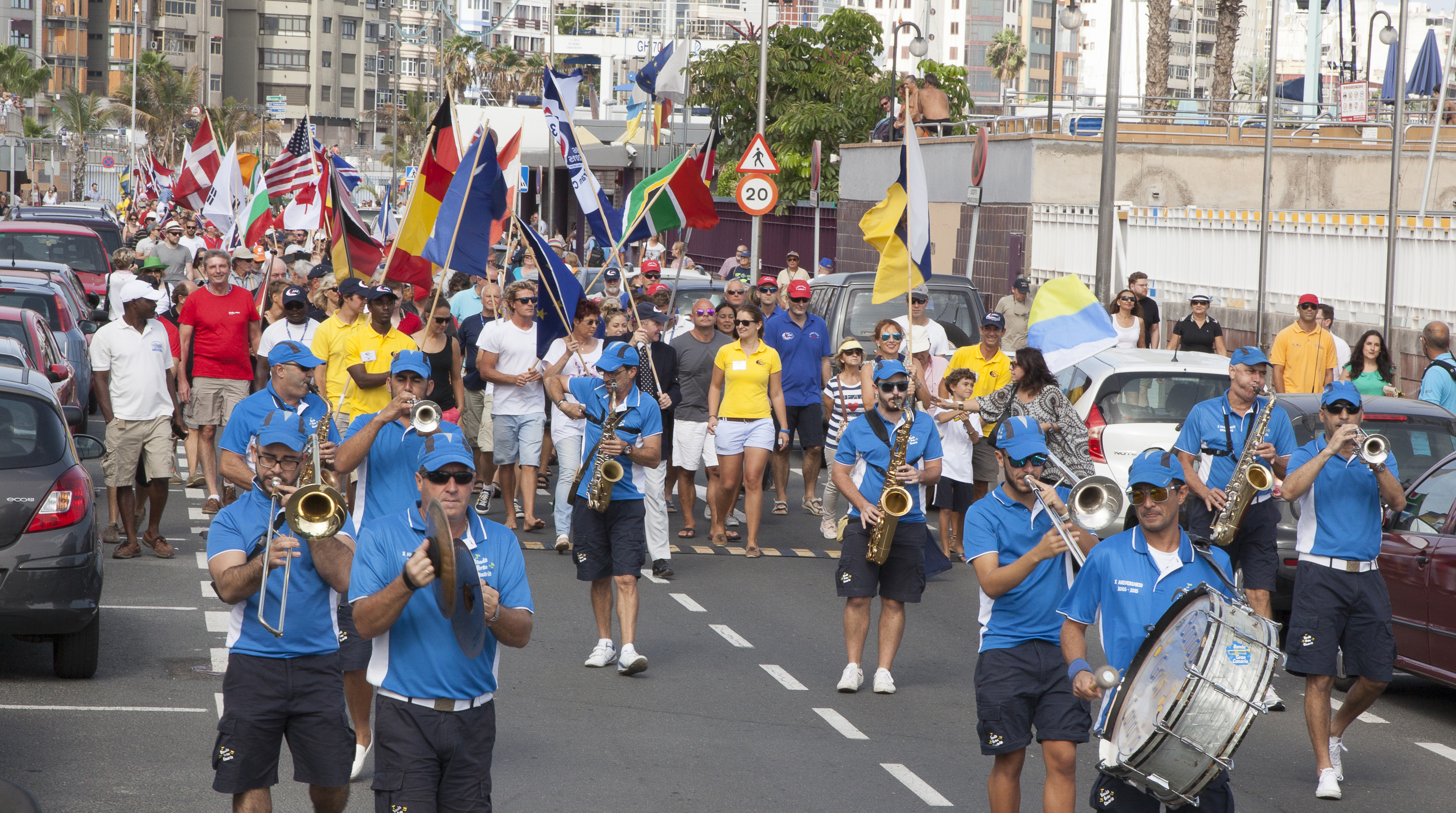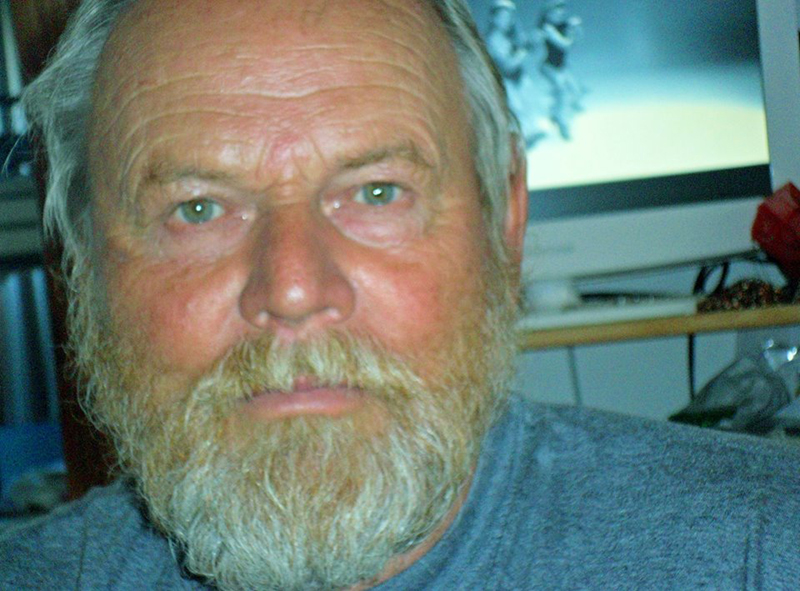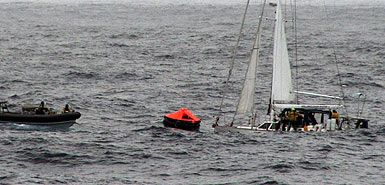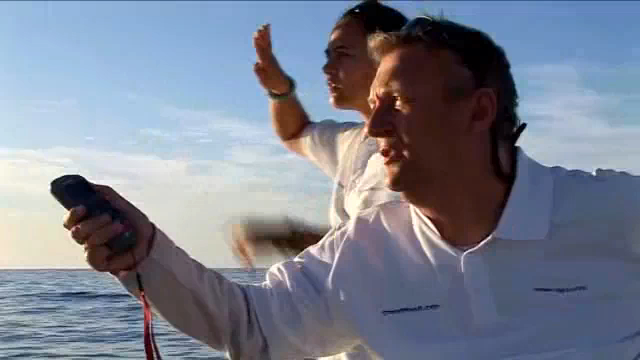Excitement is building and tensions are high as final preparations get under way in Las Palmas de Gran Canaria for tomorrow’s Atlantic Rally for Cruisers (ARC) start day.
More than 1,200 sailors are taking part in the 30th edition of the rally across the Atlantic. Organisers are pleased to be welcoming back several participants who sailed with the first edition in 1986 to this year’s start line.
In the region of 200 yachts are due to set sail tomorrow, 22 November, with the direct route to Saint Lucia, of which 53 of the yachts are under 13m LOA.
Two weeks ago, the largest ever ARC+ fleet of 64 yachts departed Las Palmas on 8 November, bound for Mindelo, Cape Verde. Following the stopover to explore, the fleet are now underway again for Leg 2 across to the Caribbean, reaching Rodney Bay before boats sailing the direct route arrive.
The voyage will take the ARC participants around 12 to 21 days, depending on their boat size and weather conditions.
Forecast
ARC weatherman Chris Tibbs said: ‘With a small area of low pressure developing over north Africa the wind will back to the N-NE and increase over the weekend with an increasing chance of showers late Saturday and into Sunday.
For the start the wind is expected to be N-NE at 15-20 knots (force 4 to 5) although it will be lighter and more variable in the harbour. There will be a general increase in wind as the boats get south and approaching the airport acceleration zone the wind is expected to be around 30 knots. Once south of the island the wind is expected to stay N-NE 20-25 knots over Sunday night. There will be some squally showers.’
There are many inspirational stories to be found among the ARC competitors. Here PBO chats to a few of the sailors gearing up for the Atlantic crossing…
Unfinished business
Originally the 26-year-old Starlight 39 yacht Rhumb (GBR) was due to sail with ARC 2014 but sadly, as a result of an unwell skipper and sick boat, the crew were forced to withdraw from the rally. Auto-helm problems were encountered which meant a return to Marina San Miguel, Tenerife for repair. Alongside this, experienced skipper David Barber had to leave the boat due to the effects of a recently diagnosed illness.
This year, the yacht has been re-entered, crewed by four of David’s friends – Brian Alderson, 67, John Underwood, 66, Ian Whitelock, 66, and Tim Gray, 59. David will be flying out to join them for a sail in the Caribbean in January.
Skipper Bryan, who has sailed the ARC twice before, said that in an earlier ARC crossing, he and Ian had experienced steering failure and the ARC brought a boat within one mile, for visible support. He said: ‘The ARC is really good value for money. Our entry fee was about £1,000 for the boat and £125 per head for the crew. It makes sailing the Atlantic that much more reassuring for a crew of four.
Preparations for the ARC included installing a watermaker, putting a generator and a satellite communications system on board and fitting a new fridge and freezer.
Bryan’s wife-to-be Anne kindly flew over to Las Palmas and rented an apartment where she has been cooking and freezing all the main meals for the voyage including beef stews, spaghetti bolognaise, chilli, ‘spoon food we can eat one handed.’
Bryan said: ‘She’s an honorary crew member, she doesn’t like sailing, we had an accident about 10 years ago on our boat and it put her off, she’s warming to the idea a bit though.’
He added: ‘We’re one of the oldest crews and we’re on one of the oldest boats.’
Crew Jon Underwood said: ‘Our kitchen facilities on board are limited but we’ve got an excellent freezer and a good beer fridge. We’ve got a water maker and a diesel generator.’
Last year they were forced to turn back after about 500 miles. John said: ‘We were making our way back last year in the worst weather the ARC had seen before. I’m not the most experienced of sailors but I actually had no fear despite the terrible conditions because of the support of the ARC team ashore.’
This year they have fitted a sunshade and seats on the aft quarters. John added: ‘We’re going to get there this year, no mucking about.
Friends reunited
Paul Thompson from Dorchester, Dorset and David Everett from Adelaide, Australia are reliving their cruising days from nearly 30 years ago on the Contessa 32 yacht Pisces (GBR). The pair met in Australia in 1978 when Paul was travelling and spent more than a year sailing together, covering more than 10,000 miles.
Paul said: ‘We went our separate ways. David is a consultant paediatrician, I’m a retired Rheumatologist. Now we’re getting together to do the ARC and revisit an old thing, see if we can do it and have a bit of fun.’
The duo are sailing a Contessa 32, which was built in 1978, the second smallest boat in the fleet ‘and definitely the oldest’.
David said in an ARC seminar they were told the definition of a double-handed yacht is essentially ‘solo sailing 24 hours a day as one of you is on watch all day, every day’. Paul added: ‘We’ve got new everything really for this rally. We’re one of the few boats here with a twistle rig.’
The pair have a Honda petrol generator and no water maker, instead they have about 240 litres in two separate tanks and bottles.
David added: ‘It’s for drinking and cooking, no washing, you’ll smell us coming.’
Paul clarified: ‘We have a salt water pump at the sink for washing.’
Seadogs on board
Dawn Kelly and her partner Martin Whitfield are taking their two dogs along with two crew on their Southerly 42 RST yacht Dawn Chorus.
For the two border collie dogs Buzz and Bonny, the ARC 2015 will be their longest time at sea.
Dawn said: ‘Like any crew they’ve got their own way of coping. Bonny likes to be on deck all the time, to the point where you have to cover her up with a fleecy blanket and an old sail bag.
‘Buzz, if it starts to get unpleasant, goes inside and might bark at the boat as if to tell it off. Then he will have a little whine and try to get into bed with whoever is off watch.
The dogs have both got ‘state-of-the-art Ruffwear lifejackets’. While at sea, they have been trained to go to the toilet on pieces of astro turf which can then be sluiced down or dipped overboard to wash it off.
Dawn said getting the relevant documents in order to allow Buzz and Bonny to accompany them had been ‘a lot of faff’ but added: ‘Hey it’s worth it guys, when we’ll be playing in the Caribbean.’
Singer and author Dawn, who has just published a fiction book Laura’s List, described the ARC preparations as: ‘So exhausting, you forget how much there is to do and how much to spend. Without water, meat, fruit or veg, I spent 600 euros on groceries yesterday.
‘I reckon we’ve spent around 1,500 euros in total. And we had the boat hauled out and checked after a worrying dive report, which turned out to be cosmetic damage, and paid 600 euros for a surveyer to come and tell us that you could put two elephants on this boat.
‘I feel like I can’t cope with much more of the preparation work, I can’t wait to go sailing when there’s nothing more you can do. I just keep thinking of the little Dory in Finding Nemo who sings ‘Just keep swimming, just keep swimming…’ For us it will be ‘Just keep sailing.’
‘Naval tradition is nothing but rum, sodomy and the lash’ – Winston Churchill
Couple Terysa Vanderloo and Nick Fabbri are gearing up for their first Atlantic crossing in their Southerly 38, Ruby Rose (GBR), together with friends Neil and John.
Their blog name www.rumsodomyandthelash.com was taken from an (alleged) quote from Winston Churchill. Nick and Terysa have embraced the live-aboard lifestyle by renting out their London flat and putting everything in storage. Nick’s dental practice was sold and Terysa quit her job – the eventual aim is a circumnavigation.
Terysa said: ‘We’ve been excited, nervous, gone through abject terror. It’s exciting but it’s the fear of the unknown. The most we’ve done before is three days offshore but someone once told me if you can cruise the English Channel you can cross the Atlantic, so I’m holding onto that.
‘I’m excited, I’m ready to go and even if it’s horrific we’ve got the Caribbean to look forward to.’
She added: ‘The ARC has been absolutely amazing, we’re planning on a circumnavigation so we’re now thinking about the World ARC because we’ve been so impressed with the level of organization and service you receive, it’s really good.’
The pair have installed a Watt&Sea hydro generator in addition to a wind generator, two 100 watt solar panels plus a hydrovane.
Nick said an early test of the hydro generator had been positive: ‘It didn’t fall off the back! It worked well although I’m not sure the proper figures given by the manufacturer reflect the figures we’re going to get from the power, but we were only doing 5 knots out there. We’ve got two propellers for it and we had the big propeller on.
‘It works and it doesn’t make any noise which is important to us as our sleeping quarters are right next to it. The plan is to drop it in the water when we set off and leave it there until St Lucia.’
He added: ‘We’re quite a power hungry boat because we run it like a house, with the exception of a dishwasher we’ve got everything on board. We want to power DVDs, a breadmaker – our one luxury – and a watermaker.’
Going electric
Janne Kjellman has fitted his company Oceanvolt’s SD15 saildrive electric motor system to his Maestro 40 yacht, Limone (FIN), a semi-light displacement cruising boat built on the Finnish west coast. The SD15 has enough power to allow manouvering in tight spaces. The regeneration function also allows the skipper to charge the batteries while sailing – a useful feature on longer voyages such as the ARC when the boat’s appliances can all be powered from the propulsion battery.
Janne said: ‘The boat was built seven years ago, I had another brand electric engine installed but I wasn’t really happy with that. Then I started to produce this engine.
‘Oceanvolt is my company and over 100 units have been sold this year, my boat is the test bench for everything.’
‘It’s a Lithium iron phosphate battery.
‘I’ve also installed a Watt&Sea hydro generator. While sailing the main engine works as a generator if we go at six knots or more.
‘The Watt&Sea worked during a brief test. I’ve tried previous towed generators before on my old boat and found them to be very old fashioned and not very efficient.’
Janne, who will be sailing the ARC with a crew of five on board, also has 600 watts of fixed and removable solar panels his yacht.
He said the electric engine plus battery was still lighter than a diesel engine and diesel. Altogether the electric batteries (house battery and propulsion battery) would cost about 15,000 euros.
He added: ‘The batteries are getting lighter and cheaper every year. It’s definitely the future, I haven’t met any sailor who says ‘I love diesel so much’.
‘The whole system costs two and a half times what you pay for diesel but in five years it will start to be even with the cost.’
The 100% electric powered yacht Limone has already covered thousands of miles – with all the power on passage generated from the sun and boat’s movement – so Janne is confident about the Atlantic crossing.
He said on the 3,500 mile journey from Helsinki to Las Palmas: ‘We had some troubles as we needed to sail a lot and when we came through the Kiel Canal, about 90km with a headwind the whole time, we needed to stop two times overnight to charge the batteries. But other than that it’s done really nicely.’
Innovative bow thruster
Dutch sailor Duco Pulle, who lives in Australia, has designed an innovative bow-thruster for his Najad 34 yacht Brietr to boost the yacht’s maneuverability. Duco, who has a PHD in electrical engineering from Leeds, bought a conventional bow thruster unit and then removed the 12V brushed DC motor from the gear leg assembly and replaced it with a three-phase permanent magnet synchronour motor, which is 50% lighter.
He said: ‘I put in on the boat simply because I felt it needed a change.’ He added: ‘It’s got mains power, it’s a revelation.’
Experienced sailor Duco will be doing the ARC and then carrying on to Australia with his crew, a female Dutch sailor who lives in Australia, who he found on the Ocean Crew Link crew finder service.
Setting sail
This year World Cruising Club communications director Jeremy Wyatt will also be swapping his shore-side support role at the 11th hour to crew in the ARC, in honour of his 50th birthday year. Jeremy will be sailing with meteorologist Chris Tibbs – who sailed in the original 1986 ARC – and his wife Helen on their Wauquiez Centurian 40s Taistealai (GBR).
Jeremy said: ‘Chris has done masses of sailing, including the Whitbread twice and the Global Challenge so he’s a very comfortable, relaxed and easy person to be on board with. I’ll be in good company.
‘Normally when you’re organizing it you can’t sail in it, it’s quite hard to do both, I had to get the co-operation of my colleagues to be able to do it, so a big thank you to them.’
Jeremy added: ‘I’ve done a lot of racing sailing but I don’t seem to get to do much offshore these days. Chris and Helen decided to do the ARC last year and I was very pleased because I was the first person they asked to crew for them.
‘At the end of today I will take off the yellow shirt and put on a crew shirt.
Tomorrow’s rally start will have three phases, beginning at 12.30pm with the multihull and open divisions, followed by the racing division at 12.45pm for all other divisions at 1pm.
Track the fleet
All boats are fitted with a YB Tracker and the tracking page is now live on the website. Boats are already sending in blogs and photos from Muelle Deportivo, follow the adventure on the ARC Facebook page, via Twitter and on the World Cruising Club website.
ARC+ 2015 sets sail
The 64-strong ARC+ fleet set sail from Las Palmas de Gran Canaria amid a gentle swell, warm sunshine and an…
New ARC Channel Islands 2016 Rally – open for registration
More than 50 people gathered at the RYA lounge to learn more about the new ARC Channel Islands rally taking…
Yacht sailors called on to help with research
Survey findings will help the RNLI, RYA and MCA develop tailored safety messages for yacht sailors
An international parade officially opens the 30th Atlantic Rally for Cruisers
With one week to go before the ARC 2015 fleet leave Las Palmas for Rodney Bay in Saint Lucia, crews…
30th Atlantic Rally for Cruisers prepares to set sail
This November, more than 260 boats and 1,250 people will take part in the 30th Atlantic Rally for Cruisers, heading…
‘Ghost yacht’ sunk by Irish Naval Service after crossing the Atlantic
A yacht that crossed the Atlantic after being abandoned more than a year ago has been sunk just as its…
Dutch sailor missing in the Atlantic
Solo sailor Sietse Hagen hasn't been heard from for more than two months
Yacht family of four rescued in South Atlantic
HMS Clyde arrives in the nick of time
Geoff Holt’s first broadcast from the Atlantic
Return to Tortola












